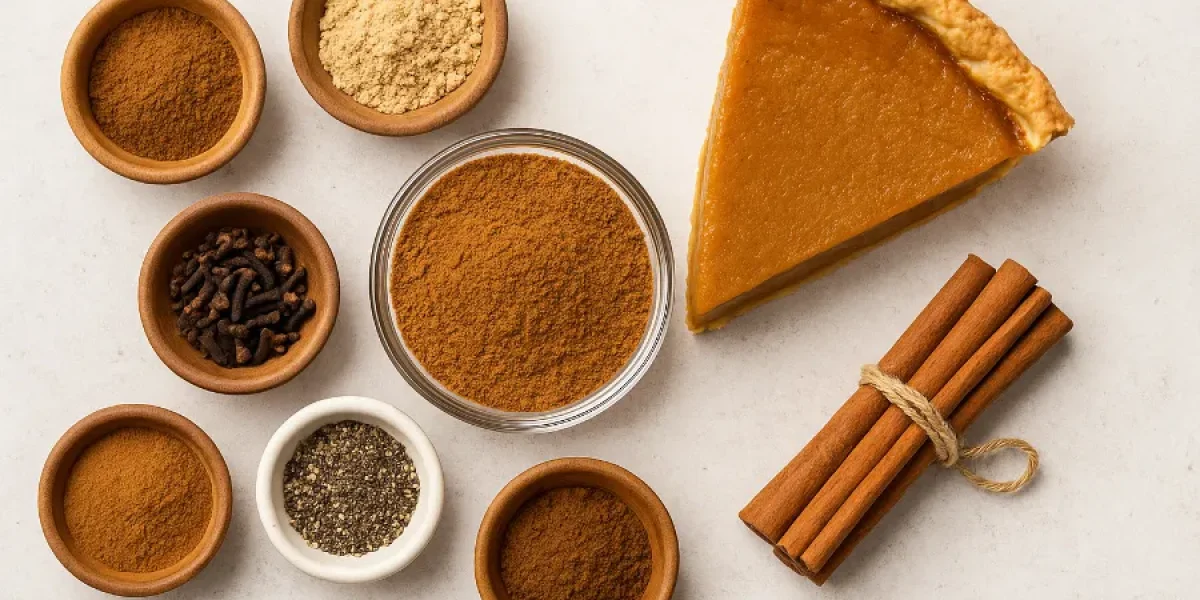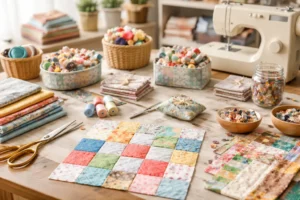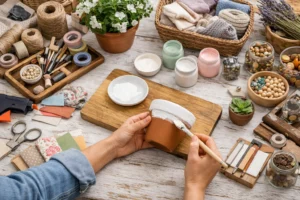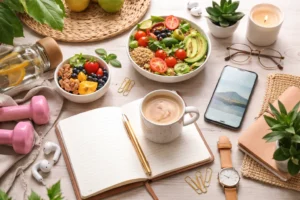Every fall, I find myself in the same spot — standing over a bowl of pumpkin purée, inhaling that earthy sweetness, and asking the age-old question: What’s the best spice ratio for homemade pumpkin pie?
Because let’s be honest — the pumpkin isn’t what makes pumpkin pie irresistible. It’s the pumpkin pie spices — the comforting warmth of cinnamon, the spark of ginger, the hint of clove that says, “Yes, it’s finally fall.”
But too often, the balance is off. One batch tastes like cinnamon soup. Another feels sharp and hollow.
So today, we’re going to perfect it together with the 8 best spices for pumpkin pie, from the familiar to the daring, plus exact ratios for one 9-inch pie.
Pumpkin Pie Spice Ingredients That Make Magic
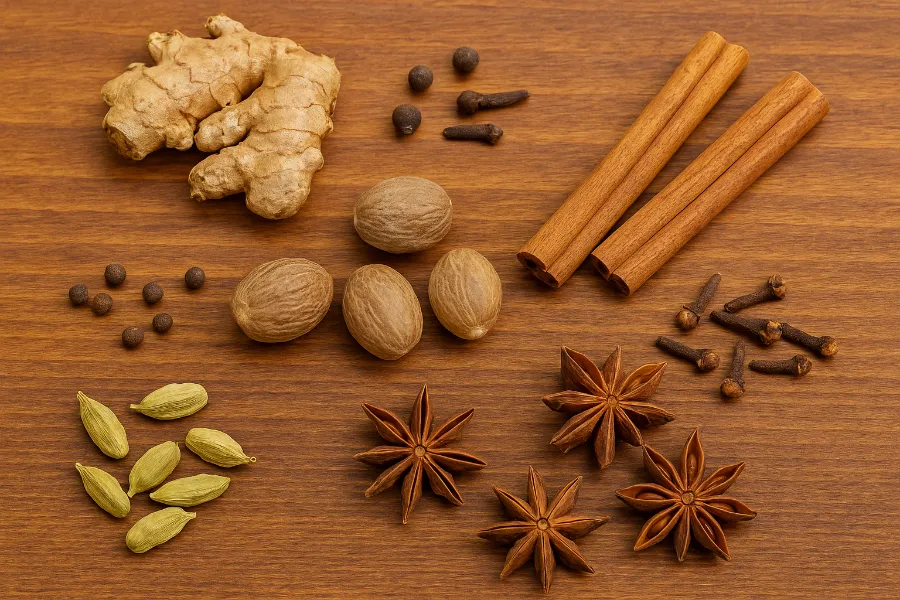
Let’s start with what goes into that famous blend.
A classic pumpkin pie spice mix includes:
- Cinnamon
- Ginger
- Nutmeg
- Clove
- Allspice
But that’s only the beginning. Once you master those five, there’s a whole world of flavor to explore — cardamom, Chinese five spice, and even black pepper — spices that make your pie taste bakery-level rather than basic.
Here’s the master ratio for one perfect pie (about 2 cups of filling):
The Best Spice Ratio for Homemade Pumpkin Pie:
- 1½ teaspoons cinnamon
- ¾ teaspoon ginger
- ½ teaspoon nutmeg
- ¼ teaspoon cloves
- ⅛ teaspoon allspice
- ⅛ teaspoon cardamom
- ¼ teaspoon Chinese five spice
- ⅛ teaspoon black pepper
It’s balanced, warm, aromatic, and layered — a symphony instead of a solo. Let’s break down why each spice earns its spot.
Pumpkin Spice and the Heart of Autumn
When people say “pumpkin spice,” what they really mean is nostalgia. It’s the smell of pies cooling on a windowsill, the hum of family chatter, the first cozy sweater day.
But pumpkin spice and pumpkin pie spice aren’t quite the same.
Pumpkin spice is lighter and sweeter perfect for lattes and muffins while pumpkin pie spice is deeper, darker, and richer. It’s built to hold its own inside custard and cream.
So while your candle might smell like “pumpkin spice,” your pie should taste like something fuller — spices in harmony, not just cinnamon doing all the work.
Spice Blend Recipe: The Flavor Blueprint
Here’s where we start balancing art and science.
Spices each have their own natural oils that behave differently in heat, sugar, and fat. When you get the ratios right, your pie will smell like comfort itself — when you don’t, something feels just a little “off.”
This spice blend recipe works because every element has a role:
- Cinnamon: warmth and body
- Ginger: brightness and lift
- Nutmeg: creamy undertone
- Clove: depth and structure
- Allspice: harmony
- Cardamom: elegance
- Five spice: intrigue
- Black pepper: the unexpected finish
Let’s meet them one by one.
Cinnamon – The Soul of Pumpkin Pie
If pumpkin pie were a song, cinnamon would be the melody. It’s sweet, familiar, and instantly comforting. But here’s the secret most bakers don’t talk about: there are two types of cinnamon, and they can make or break your pie.
Ceylon vs Cassia Cinnamon
- Cassia cinnamon is what you’ll find in most grocery stores. It’s strong, spicy, and bold — that unmistakable “pumpkin spice latte” flavor.
- Ceylon cinnamon, often called “true cinnamon,” is more refined. It’s lighter, floral, and subtly citrusy.
For the perfect blend, I like to use 1 teaspoon cassia and ½ teaspoon Ceylon — the cassia provides warmth, and the Ceylon smooths it out like cream in coffee.
Ratio: 1½ teaspoons total per pie
Why it’s essential: Cinnamon is the structure that holds the whole spice mix together. It gives that familiar autumn heart.
Ginger – The Spark That Keeps It Alive
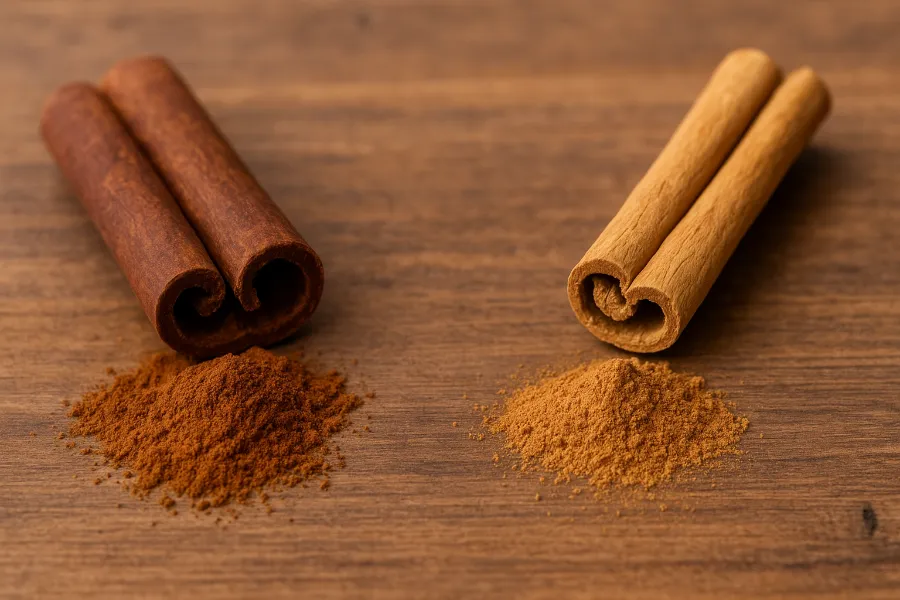
Without ginger, pumpkin pie can taste sleepy.
Ginger is the spice that wakes it up — a zesty note that cuts through the creamy custard and keeps each bite bright. Ground ginger gives subtle heat, while a touch of fresh ginger (if you’re feeling bold) adds zing.
It’s the difference between “good” and “I need another slice.”
Ratio: ¾ teaspoon per pie
Why it’s essential: It adds freshness, prevents cloying sweetness, and balances cinnamon’s warmth with lively sparkle.
Nutmeg – The Cozy Middle Note
Nutmeg is your pie’s soft hum in the background — you don’t taste it first, but you’d miss it if it were gone. It smells like warmth and nostalgia, like old recipe cards and family dinners.
Always grate nutmeg fresh if you can — the pre-ground kind loses its magic fast.
Ratio: ½ teaspoon per pie
Why it’s essential: Adds subtle sweetness and creamy depth; ties the spices together with elegance.
Cloves – The Deep Bass
Cloves are powerful — like the bass note in music, you don’t need much to feel their presence.
They’re earthy and rich, with a little bite that deepens the entire blend.
Just don’t go overboard. Too much, and your pie will taste medicinal.
Ratio: ¼ teaspoon per pie
Why it’s essential: Grounds the pie with bold warmth and makes the flavor feel “complete.”
Allspice – The Quiet Harmonizer
Allspice is the peacemaker of the blend.
Despite its name, it’s a single berry, not a mix — but it somehow tastes like cinnamon, nutmeg, and clove all rolled into one.
Ratio: ⅛ teaspoon per pie
Why it’s essential: Balances the stronger spices, fills in the gaps, and gives that “bakery” aroma.
Cardamom – The Unexpected Sophistication
Cardamom is that friend who walks into the room and makes everything feel more elegant.
It brings a whisper of mint and citrus that lifts the pie from homey to high-end.
If you’ve ever tasted a Scandinavian pastry and thought, why does this taste so good?, it’s probably cardamom.
Use green cardamom — it’s floral and clean. Grind it fresh if you can.
Ratio: ⅛ teaspoon per pie
Why it’s essential: Adds brightness and complexity; it’s your secret signature ingredient.
Chinese Five Spice – The Global Twist
Now we’re venturing into adventurous territory.
Chinese five spice is a mix of star anise, cloves, cinnamon, fennel, and Sichuan peppercorn — a combination that adds warmth with a gentle licorice twist.
It doesn’t make your pie “Asian,” but it adds that little something that makes people wonder what your secret is.
If you use this, slightly reduce your cinnamon to avoid overpowering the blend.
Ratio: ¼ teaspoon per pie
Why it’s essential: Adds depth, complexity, and an aromatic layer that lingers beautifully on the palate.
Black Pepper – The Bold Little Secret
You might raise an eyebrow at this one, but black pepper is an old-school baker’s trick. It doesn’t make your pie spicy; it just brings everything into focus. Freshly ground fine pepper gives your pie a subtle warmth — you won’t taste it, but you’ll notice the enhanced aroma and balance.
Ratio: ⅛ teaspoon per pie
Why it’s essential: It’s the counterpoint that keeps sweetness in check and flavor vibrant.
Building the Perfect Spice Blend Recipe
Now that you’ve met the stars of the show, here’s how to mix them:
For one 9-inch pie:
1½ tsp cinnamon
¾ tsp ginger
½ tsp nutmeg
¼ tsp cloves
⅛ tsp allspice
⅛ tsp cardamom
¼ tsp Chinese five spice
⅛ tsp black pepper
Whisk everything together in a small bowl before adding it to your filling.
If you want to make a larger spice blend recipe to store for the season, just multiply the measurements by four and keep it in a sealed glass jar for up to six months.
Why Toasting Your Spices Changes Everything
Here’s the secret that turns a good pie into an unforgettable one: toast your spices. Heat a dry pan over low flame, toss in your measured blend, and stir gently for about 30 seconds — just until it releases that intoxicating aroma.
This step blooms the essential oils, creating a deeper, more complex flavor.
Once you’ve done it, you’ll never skip it again.
Ceylon vs Cassia Cinnamon (Round Two: Choosing Your Signature Flavor)
Cinnamon deserves a little more love, because the difference between Ceylon vs cassia cinnamon is bigger than most people realize. If you love that bold, nostalgic “pumpkin spice latte” punch — cassia is your cinnamon.
If you prefer a refined, gently sweet pie that smells like a patisserie — Ceylon is the one.
Or do what I do: blend both.
Cassia for strength, Ceylon for finesse. Together, they taste like comfort and craft in one bite.
How to Customize Your Pumpkin Spice Blend Recipe
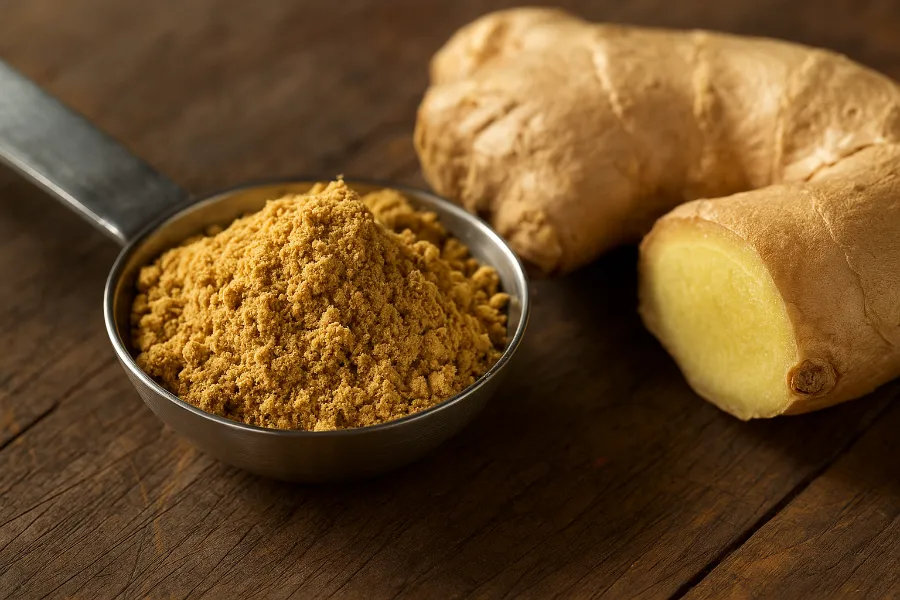
Once you’ve nailed the master ratio, play a little.
Here are a few variations to make it your own:
- Sweet & Classic: Add ¼ tsp vanilla bean powder or reduce ginger slightly.
- Warm & Bold: Add 1 pinch extra black pepper and ⅛ tsp smoked cinnamon.
- Elegant & Floral: Add ¼ tsp extra Ceylon cinnamon and ⅛ tsp more cardamom.
- Spicy & Lively: Increase ginger by ¼ tsp and add a pinch of cayenne.
The key is balance. Taste your mix before adding it to the filling — it should smell layered and warm, not sharp or overwhelming.
Buy Pumpkin Pie Spice Or Make Your Own?
If you only bake once a year, it’s completely fine to buy pumpkin pie spice from a trusted brand. McCormick, Simply Organic, and Frontier Co-op make solid versions.
But if you’re serious about flavor — or just love that intoxicating smell of freshly mixed spices — nothing beats homemade.
Why?
- Store blends are 70% cinnamon, leaving little nuance.
- Homemade blends let you adjust sweetness and depth.
- Freshly ground spices bloom more aroma and complexity.
So yes, you can buy pumpkin pie spice, but if you love to bake, I promise: the custom blend is worth every stir.
How to Store Your Pumpkin Pie Spices
Once you’ve crafted your perfect mix, store it like a pro:
- Keep it in a small glass jar or airtight tin.
- Store it away from light and heat (a pantry or spice drawer is ideal).
- Label it with the date — most blends keep their punch for about 3–4 months.
When the holidays roll around again, you’ll have a ready-to-go jar of autumn waiting to be whisked into batter.
Final Thoughts: The Best Spice Ratio for Homemade Pumpkin Pie
In the end, the perfect pumpkin pie isn’t about canned purée or fancy crusts — it’s about balance.
Each spice brings its own character:
- Cinnamon comforts.
- Ginger excites.
- Nutmeg soothes.
- Clove deepens.
- Allspice balances.
- Cardamom intrigues.
- Five spice expands.
- Pepper surprises.
Together, they create something greater than the sum of their parts — the flavor of fall itself.
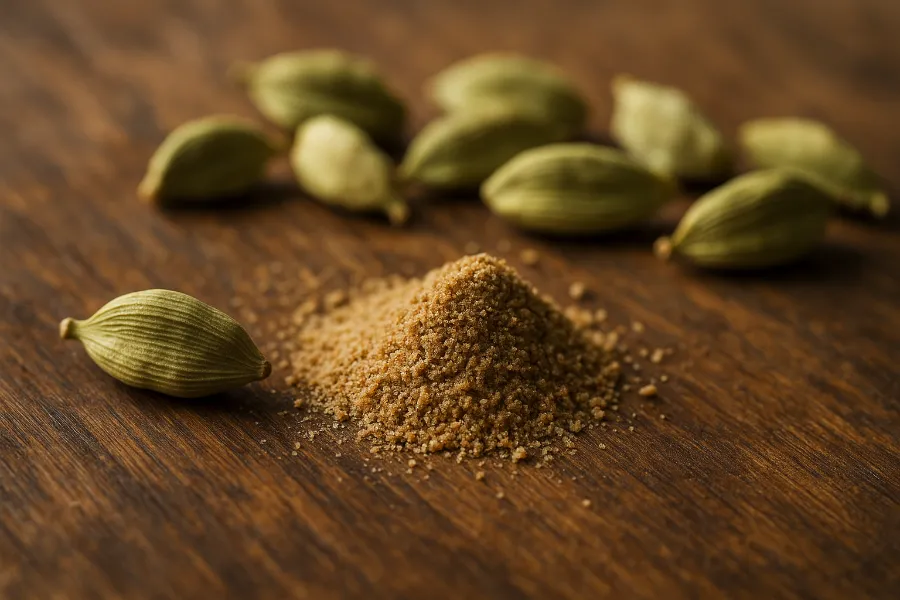
So next time you bake, skip the jar and trust your nose.
Toast your spices. Blend them by hand.
And when that pie comes out golden and fragrant, you’ll know: this is your signature — your version of autumn in a slice.
FAQs
The classic pumpkin pie spice ingredients include cinnamon, ginger, nutmeg, cloves, and allspice. These create the warm, balanced flavor that defines traditional homemade pumpkin pie.
For one 9-inch pie, use 1½ tsp cinnamon, ¾ tsp ginger, ½ tsp nutmeg, ¼ tsp cloves, and ⅛ tsp allspice. Add a pinch of cardamom or black pepper for an elevated, bakery-style flavor.
Not exactly. Pumpkin spice is sweeter and lighter, perfect for lattes or muffins, while pumpkin pie spice is richer and designed to enhance creamy custard fillings.
Combine ground cinnamon, ginger, nutmeg, allspice, and cloves in a small jar. Store in an airtight container and use 2–3 teaspoons per pie or recipe for a perfectly balanced result.
Ceylon cinnamon is light, floral, and slightly citrusy, while cassia cinnamon is bold, warm, and spicy. Blending both gives the best of each — smooth sweetness with cozy depth.
Yes, you can buy pumpkin pie spice if you bake occasionally, but homemade blends are fresher and customizable. Store-bought versions often rely heavily on cinnamon and lose aroma faster.
When stored in a cool, dark place in an airtight jar, your spice blend will stay fresh for about 3–4 months. For the strongest flavor, mix a fresh batch every fall season.

